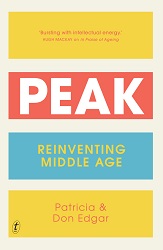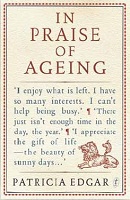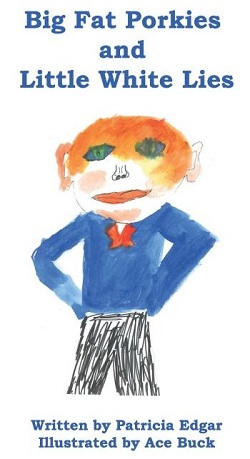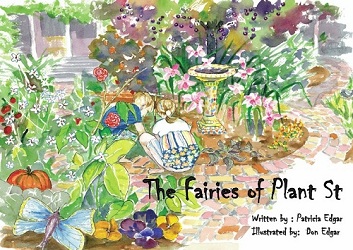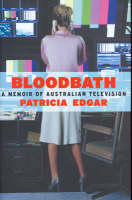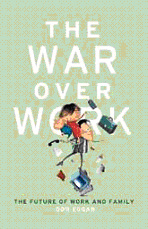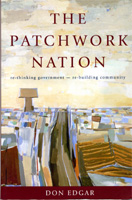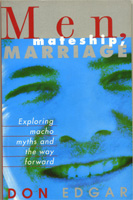More about Bloodbath: A Memoir of Australian Television
Chapters:
Part 1: Getting started
- Looking for trouble
- Getting into television
- Enter Bruce Gyngell
- A vision for children's television
- Showdown in Canberra
- Towards a Children's Television Foundation
- Dirty politics
- Bad blood
Part 2: The Producer
- Winners indeed
- Fraud and recovery
- Round the Twist
- A program for life
- From dream to reality
- The ABC and Pay School
- The independent producers
Part 3: New Challenges
- The Keating years
- Vulnerable people
- A partnership unravels
- Time to go
- Exit left
Afterword: Children - the miner's canaries
What others say about Bloodbath:
Paul Kalina , The Age, June 29th 2006 :
“The Australian television industry has bred loads of local luminaries. But 10 people stand out as the innovators whose inspiration and drive forged the development of local programming to what it is today…
A tireless supporter of children's television and local production, Patricia Edgar has strenuously argued throughout her career that television is a tool for educating audiences and shaping cultural values.”
Reviewer Dianne Dempsey The Age December 2nd, 2006 “ A lone woman in the nascent
Australian television industry, Patricia Edgar forged a career with few precedents, in the
areas of policy, regulation and children's production…You have to admire Edgar's push-
through style”
Reviewer Bruce Elder Sydney Morning Herald, November 4th, 2006
“What a title for a book by Australia's leading authority on children's television…this is Patricia Edgar's autobiography recounting her life with admirable objectivity and meticulous detail…By the end it is easy to understand why (she) has been such a powerful force in children's television.”
Reviewer Wendy Keys Australian November 1, 2006.
“Bloodbath is a riveting read… Whether you're interested in the intricacies of
Australia's TV industry or not, the energetic drama and first hand witnessing of dastardly
behaviour during Australia's early TV years delivers amusing and poignant moments.The
story also elicits frequent gasps of astonishment.”
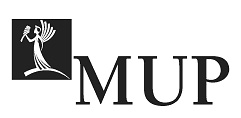
BLOODBATH
A Memoir of Australian Television
Patricia Edgar
Publication: 25 September 2006
MUP $45.00
'I would regard Patricia Edgar as a sort of human tank. Patricia is a sort of Centurion in her abilities to kick down doors and push walls over. She is annoying, irritating, relentless, drives people mad, but she gets things done…'
Phillip Adams
Patricia Edgar has been named one of the ten most influential people in the development of Australian television production. Her candid memoir is a provocative insider's look at the television industry and its politics over 30 years.
Dr Edgar was the first Australian woman appointed to a national role in television regulation. As a policy maker and regulator, she fought for more locally produced, first-release children's drama on Australian television. Her take-no-prisoners style won her great fans but also made her bitter enemies, particularly inside the commercial networks and the ABC.
In the early 1980s she helped establish the Australian Children's Television Foundation. For 20 years as its founding director, Dr Edgar spearheaded the creation of a celebrated canon of children's television programs, including Round the Twist, which sold into more than 100 countries. Her work brought her into close contact—and in some cases, conflict—with the likes of Bruce Gyngell, Janet and Robert Holmes à Court, Phillip Adams, Paddy Conroy, Simon Townsend, Jennifer Byrne, Galarrwuy and Mandawuy Yunupingu, Bob Ellis, Paul Jennings, and overseas with senior executives from the BBC and Disney.
Bloodbath also tells Patricia Edgar's own story—of how a young girl from Mildura became a leading innovator in children's television, and a voice to be reckoned with in a tough business. In the fiftieth year of Australian television, this is the media memoir of the year.
Preface to Bloodbath
This is a personal memoir about my role in Australian television: a career which spanned thirty years, in an industry which is savage when its commercial interests are challenged. I began in an era when women found it difficult to have a say in educational institutions, government and the media, without being ridiculed. Yet it was also a time when it was possible to implement social change, when politicians and leaders would respond to ideas for social change and I believed I could help build a better future. My roles in the development of television policy, regulation and children's production were part of a broad movement aimed at developing Australian culture - its film, literature and arts generally - to showcase our country, its people and its place in the world. The success of Australian content policy - despite strong and vitriolic opposition - led to the building of an Australian film and television production industry of world standing.
This year 2006 marks fifty years of commercial television in Australia. I regard the late Bruce Gyngell, the presenter who welcomed Australians to commercial TV in Channel 9's inaugural broadcast, as one of my mentors in the industry. As chairman of the Australian Broadcasting Tribunal, he gave me an opportunity that opened up ideas, friendships and possibilities that fuelled me for the next twenty-five years. I once promised Bruce, in the midst of yet another controversial moment in his own career, that I would one day write the history of children's programming in Australia.
But the main reason this book was written was the persistent and gentle persuasion by my husband Don Edgar. I was full of reasons why not: it would take too much time; I didn't want to revisit painful periods in my life and didn't want any self justification for events that were contentious. There were practical problems: I am a hoarder of papers, but they would need to be sifted and put in order; I couldn't write with psoriatic arthritis in my hands.
And so it went on until we decided to clean out the accumulation of forty-five years of our working lives. I rediscovered many boxes of files in the roof space of our home, including five years of papers covering all the meetings of the Children's Program Committee of the ABT held in Gyngell's time there. The Tribunal had gone, along with official records; my papers were the only surviving record. As I began to read details I had long forgotten, I was surprised by the passion and conflict that emerged from the pages. I relived the struggle to establish official Standards that would promote quality Australian children's television programming.
It was my experience as chairman of the Children's Program Committee that led me to the most significant role of my career, as founding Director of the Australian Children's Television Foundation. Reading through my papers I started to think of reasons I might write the whole story down. I remembered my promise to Bruce Gyngell. And I reflected that the quality of Australian children's television is now taken for granted. Those who had had to fight for it and knew the history, were dead or growing older and no longer in the public eye. I wanted to pay tribute to the creative pioneers of the industry who were very close to me and no longer with us - Frank Meaney, Garth Boomer and John Morris, in particular.
As often in my life, I was also provoked: this time by gossip about events in my career that was misleading and inaccurate. I started writing and I didn't stop. The more I wrote the more I saw the point of writing. That I was at the centre of controversial events over a thirty year history of the development of Australian television gave me a rough ride but it was an extraordinary adventure. Don was right: it is a story worth relating about an experiment that was unique in television history and has not been documented before. Although this book is written in large part about children and programming, it is also a story about the broader world of television, in Australia and globally.
Childhood under siege
|
|||||
The influence of marketers and advertisers on our children is growing. And doing nothing will result in catastrophic social and health consequences. |
Extract from speech by Patricia Edgar, at the launch of Bloodbath: a memoir of Australian television
26/9/06
Right now we are faced with critical choices which will determine whether we sink deeper into a cultural wasteland or step into the promised land of media opportunity. Will it be simply more and more sludge for the mind, or genuine diversity of opinion, debate and exposure to quality Australian content and the best cultural and entertaining experiences from around the world?
The outcome of the current media ownership debate will make a difference.
It took Paul Keating five minutes on Lateline to articulate, in typical Keating style, a message the Labor opposition seems unable to get across clearly. The proposed media ownership changes allowing cross media ownership proposed by the Howard government are in no one's interest except the current free to air networks, specifically the Nine Network. Packer Jnr can acquire Fairfax and voices of critique in our system will be fewer and more conservative. The abuse media proprietors can perpetrate on those they go after when you “cross them up” (Keating's words) will be multiplied. I experienced that abuse when the Bulletin and the Nine Network set upon me accusing me of a conflict of interest, apparently in order to force me to resign from the Children's Program Committee (of the Australian Broadcasting Tribunal). Equally the media can protect their own interests, protect their friends and ensure cover ups more thoroughly.
Eighty percent of Australians believe there is too much concentration of ownership and in a democratic system - the older I get the less sure I know what that means - but I think we should be entitled to expect the potential offered by the new media landscape will be developed for Australian benefit. It seems the media ownership policy is not really about diversity and new opportunities at all. So is it about a past political deal - a death bed pledge perhaps?
Digital free-to air TV in Australia is five years old but what have the Networks done with the opportunity they were offered to deliver a new future? They have reacted like dinosaurs squealing every time their financial interests are pricked. This has been true since they protested against the ban on cigarette advertising in 1976; they claimed they couldn't afford to pay for the introduction of colour television and make Australian programs; their response to the children's television standards was scandalous from licensees enjoying the commercial benefits of a limited public resource - now they appear to have the Government in their pocket on digital reform. The free-to-air networks have been protected for 50 years in Australia. They have been given every chance to adapt to a changing technical environment. But they have not done so.
So the ABC , with all its flaws remains critically important. It is the most important cultural institution in Australia and a most valued source of news and critical comment. The fact that it is loathed by every government of the day means it has managed to retain an independent voice under much hardship.
The government is doing its best to stack the Board with conservative thinkers in tune with their own ideology. The funny thing is intelligent people can't always be guaranteed to do what you want them to do. Witness Bruce Gyngell.
According to Ken Inglis in his recently published history of the ABC the current Chairman of the Board, John Howard's good friend Donald McDonald, is admired within the ABC particularly for his strategy in winning more funding for the ABC within this recent budget. On the other hand it may just be that it has finally dawned on the government that destroying the ABC may not be in its best electoral interests. The ABC despite its faults and they are considerable is all we have. So we must express opinion on the ABC's performance to help those within fulfill the role a public broadcaster should.
When eventually the Australian government opens up the electronic spectrum to large numbers of digital channels the economies of production and the limits to the pool of talent will mean that the need for the public broadcaster to maintain quality and diversity in programming and maintain free debate in support of the values of a democratic nation will be much greater.
The ABC however is capable of destroying itself. By dumbing down its content, sacrificing innovation and depth for cheaper programming, pleas for funding can be more easily ignored. Why should the public pay for inconsequential junk? The ABC is presented with a double bind which is no more strongly in evidence than in its children's programming.
In my experience it has been downhill all the way with the ABC since the early 1990s. David Hill and Paddy Conroy were sent on their way over sponsorship deals and the commercialization of the ABC. Despite my issues with the ABC over its potential partnership with Nickeleodeon in the mid 90s - which I write about - there were genuine efforts, under Hill and Conroy, to reinvigorate Australian drama and children's programming through the independent industry
Support for the Foundation's anthology series Touch the Sun, with its Emmy award winning Captain Johnno, ( only the second Emmy to be won by Australia); support for the brilliant Round the Twist series and the early childhood program Lift-off, which was recognized worldwide as a ground breaking innovation for young children; came from Paddy Conroy Head of ABC television. This creative partnership came to an end with the ascension of Claire Henderson to head children's programs. The ABC - our public broadcaster - has become a leader in the game of licensing, transforming children's programming into merchandise driven product for the very young. The ABC continues to seek pre-school programming concepts with “broad international potential in respect of both television program sales and ancillary rights exploitation”( ABC's Release seeking program submissions). Children are treated as a market - as consumers - rather than an audience with special needs.
Why does it matter? Young children are natural learners. Research confirms the from birth to age 5 and in particular over the first three years of their lives children learn and grow at the fastest rate they will grow in their lifetime. Development is sequential. If competence is not developed early then children's ability to develop new skills as they grow older is compromised. Lift-off was based on that understanding from research. Playschool runs on the spot. Young children like it. They like anything - Teletubbies, Barney, Postman Pat, Thomas the Tank Engine, Bob the Builder, High Five. All sell brands to pre- schoolers.
Which brings me to the independent production industry.
The debate about Australian production has shifted ground in the past decade. It used to be about how we serve our audience. Now it's about what's in it for me - the producer. What has happened to our stories - our films and our television? We have the stars - those we have bred through local content regulation and a subsidized industry. But we don't seem to have the vehicles to carry them. Did we give birth to an exceptional generation who in the 70s fought for Australian content standards, subsidy for local production, and then showed us what could be done with Gallipoli, Sunday Too Far Away, My Brilliant Career, Storm Boy, Picnic at Hanging Rock etc. and a regular supply of outstanding mini-series on television. Governments set up a Film Commission, a Film Finance Corporation, Screen development organizations in every State, a Children's Television Foundation. But the creative talent now seems in shorter supply. Have they all gone to Hollywood?
Peter Weir, Fred Schepisi, Phil Noyce, Bruce Beresford were not freaks of their time. Phillip Adams, Gil Brealey, John Morris, I and our cohorts did not spend our time writing mission statements and when we went to talk to our political leaders Don Dunstan, John Gorton, Norman Lacy and others they responded. Some bureaucrats were public servants - Cathy Santamaria and Tony Blunn among them. They helped. It was not easy but reform was possible.
I think structures become eroded little by little. Keating reshaped the production industry making us more accountable and there have been unpredicted consequences. Keating had in mind a creative nation, a mature nation with our industrial, cultural and economic future tied together. But in every area now we seek marketplace solutions.
Deal makers have entered the market-driven film and television business who couldn't put a creative idea together in a lifetime - but they can get market attachments - one reason why our films don't work as often as they might. As well co-production deals have enabled overseas partners to exploit our subsidy system and some local producers have been complicit in this abuse of our hard won structures. In children's production merchandise has become the main driver of program ideas along with the complacency of those who know how to work the system.
The Australian Communications and Media Authority (ACMA) is undertaking a review of media regulation for children over the next 12 months. This review should be comprehensive. It could be another chance to correct the system as the Television standards are overdue for review. Kids are a jump ahead of broadcasters, teachers and producers in their use of technology. Reform is not just about television anymore. Any system of regulation has to be an ongoing process. We have to keep at it.



